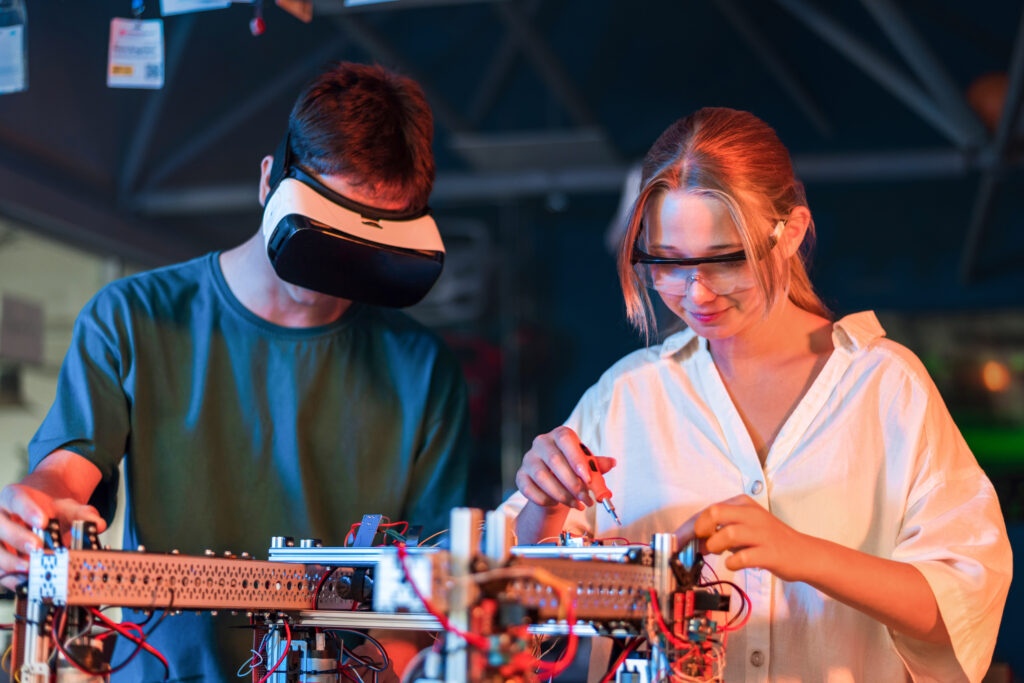
 By Dr. S M Shashidhar 03 DEC 2023 | 5min Read
By Dr. S M Shashidhar 03 DEC 2023 | 5min ReadThe field of electronics and communications engineering is advancing rapidly, shaped by various emerging technologies spanning 5G communications, artificial intelligence (AI), Internet of Things (IoT), flexible electronics, and more. These technologies are getting increasingly embedded into modern devices and systems, right from smartphones to aerospace platforms, transforming user experiences. For engineering students, specializing in these futuristic technologies presents a multitude of opportunities to build an exciting and impactful career.
Current Trends and Developments
Several new developments have already come to the market this year, highlighting the tremendous progress. For example, major Indian telecom operators started rolling out their 5G services in 2023 after years of network upgrades. Leading names like Jio, Airtel, and Vi have launched their 5G high-speed, low-latency networks in major cities allowing consumers faster streaming, gaming, and more. This will spur developments in smartphones, Wi-Fi routers, and related systems to fully realize 5G’s potential.
In the semiconductor fabrication area, the India Semiconductor Mission has taken shape under the MINISTRY OF ELECTRONICS AND INFORMATION TECHNOLOGY (MeitY) to boost chip design, manufacturing, and system integration. With nearly $30 billion earmarked and tie-ups with leading technology providers like IBM and Foxconn in progress, indigenous semiconductor manufacturing seems within reach. Students can look forward to contributing across VLSI design, photolithography, packaging, testing, etc. with these upcoming fabs.
Future Roadmap
Now let’s look at key futuristic technologies and research directions that provide target areas for students to build specialization. A prime area is 6G wireless communication – the successor to 5G that promises holographic projection capabilities, and sub-millisecond latency allowing real-time AI and metaverse applications. India has already kicked off indigenous 6G research with centers at IIT Madras and the Centre of Excellence in Wireless Technology (CEWiT). From network architectures to RF photonics, signal processing, and protocol design, 6G offers many open challenges for students.
Another emerging domain is neuromorphic engineering which seeks to mimic neuro-biological architectures present in the human nervous system. Various research agencies like IISc Bangalore, DRDO, Intel, and IBM are developing brain-inspired computing hardware, algorithms, and models for efficient AI implementation. Learning methodologies followed by the human brain can greatly advance areas like computer vision, natural language processing, and cybersecurity – opening up possibilities for students to innovate.
Expanding Horizon of Applications
Now how are these technologies getting applied in real systems? 5G and AI are already being combined by tech start-ups to create smart CCTV networks for safe cities by analyzing video feeds to detect threats. Chip design companies like nSilicon are developing specialized AI inference processors for automated manufacturing inspection. IIT Guwahati researchers have fabricated printed circuit boards on flexible silk substrates using cost-effective processes, paving the way for a breed of stretchable electronics.
In the healthcare domain, AI-enabled edge devices are being researched for smart hospitals and remote patient monitoring by universities and companies. Multinational company Infineon Technologies has set up a semiconductor R&D center in Bengaluru focusing on microcontrollers, sensors, and security solutions for biometric cards, IoT medical devices, etc. Electronics engineering talent will be in demand to build personalized, smart, and secured applications across automation, surveillance, medicine, and more sectors.
Future Outlook
Industry reports forecast the Indian semiconductor market to grow from $27.2 billion in 2021 to $64 billion in 2026 – a compounded annual growth rate of nearly 24%. The proliferation of connected devices across communication networks, transportation, power grid, industrial automation, etc. will drive demand for embedded processors, sensors, and memory. Domains like defense and space also offer opportunities for engineers to apply their capability in mission-critical avionics suites and other strategic electronics.
With greater R&D investments toward cutting-edge infrastructure like 5G testbeds, semiconductor fabrication facilities, and technology incubation cells coming from both public and private players, students have abundant avenues for research. Joint programs rolled out by premier technical institutes like IITs, and NITs along with industry partners also facilitate development prototypes aligned with the latest requirements. Electronics engineering talent will be at the nucleus of technology innovation across start-ups as well as tech giants to turn ideas into products transforming India into a global hub.
By specializing in high-growth domains like intelligent systems, connected devices, data centers, chip design, etc. students can future-proof their engineering careers while driving impact through electronics. The key is to identify emerging trends, understand real-world technology requirements, and gain hands-on exposure to them.
Dr S. M. Shashidhar M. Tech, Ph.D.
Chief Mentor
SkillLiftt






